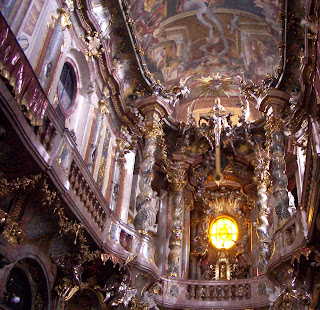Andrea Pozzo, Ceiling of St. Ignazio, Rome, 1685-94
'Di sotto in su' or 'to see from above'. Although a painting, it fits into the category of architecture because it extends the height of the church albeit in an illusionistic way. This portrays perfectly the Baroque mantra of Christianity as a power house in the days of the counter-reformation. The four corners are to represent the four corners of the world.
Trompe 'oeil, St. Ignazio
Amazingly, this isn't even a dome. The meaning of its name is 'a trick to the eye', and you can imagine why.
Francesco de Sanctis, The Spanish Steps, Rome, 1723-28
As with earlier Baroque architecture, the Spanish steps here have a 'convex and concave' sense of movement. Or in better words they're wavy.
Nicola Salvi, The Trevi Fountain, Rome, 1732-62
The late Baroque style remained strong in Rome because the pope wanted to maintain a vision of power - elsewhere it was becoming softer...
Guarino Guarini, Chapel of SS, Turin, 1667-90
As we move away slightly from Rome and move upwards towards the north west borders of Italy, the Baroque picture is different. The austerity is there, I would definitely feel absorbed into this space. BUT there is a certain obsession with shapes going on which makes you think Guarini was being playful in his design.
Filippo Juvarra, Palazzo Madama Staircase, Turin, 1718-21
Here you can see the colours lightening up a bit. Look at the concave arch to the right with the pretty blue and yellow. The head on the bannister looks like some kind of gargoyle too, although more approachable than baroque and medieval gargoyles.
Johan Lucas von Hilderbrandt, Sala Terrena, 1732-3
You can tell that the Rococo was pulling 17th and 18th century architecture out of austerity. Everything is more ornate and playful. There is also an increasing arab or eastern influence going on although there has been effort on the architects behalf to make it his own: for example the solomic-type columns (type of columns from the Temple of Solomon in Jerusalem) have been adapted to some kind of drapery.
Germain Boffrand, Salon de Princesses
Delicate, not overpowering etc...
Francois Cuvillies, Ahnengalerie, Munich, 1730
Balthasar Neumann, Vierzehnheiligen, Bavaria, 1743
Asam Brothers, Asamkirche, Munich, 1733-46
William Chambers, Chinese Pagoda, London, 1761-62
While Italy, France and Spain were amid the Baroque era in architecture, England were all about Neo-Classical architecture and a very different - but shortlived- 'English Baroque' (read about that heree). William Chambers was an English architect who studied Chinese art and had been to France and Italy. He, although famous for the Neo-Classical Somerset House, was introducing some eastern influence into the mix:
Claydon House, Chinese Room
The fashion to 'orientalise' became a massive influence throughout the country. The mix of (predominantly) eastern influence with a hint of Rococo resulted in this kind of thing:
It looks a bit shit from this photograph but in person it's definitely not as tacky!













Baroque architecture is an exuberant style of architecture that first appeared in the eponymous era in the 16th century.
ReplyDelete